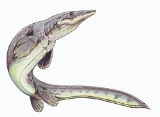
Platecarpus
Encyclopedia
Platecarpus is an extinct genus
of aquatic lizard
belonging to the mosasaur
family, living around 75 million years ago during the end of the Cretaceous
period. Fossil
s have been found in Belgium
and the United States
as well as a possible specimen in Africa
. Platecarpus probably fed on fish
, squid
, and ammonite
s. Like other mosasaurs, it was initially thought to have swum in an eel
-like fashion, although a recent study suggests that it swam more like modern sharks. An exceptionally well-preserved specimen of P. tympaniticus known as LACM 128319 shows skin impressions, pigments around the nostrils, bronchial tubes and the presence of a high profile tail fluke, showing that it and other mosasaurs did not necessarily have an eel-like swimming method but were more powerful fast swimmers. It is held in the Natural History Museum of Los Angeles County
.
.
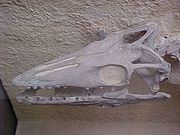 The skull structure of Platecarpus is unique among mosasaurs. This genus is characterized by a short skull, and has fewer teeth than any other mosasaur (approximately 10 teeth in each dentary).Burnham (1991) recently reported an unclassified species of Plioplatecarpus
The skull structure of Platecarpus is unique among mosasaurs. This genus is characterized by a short skull, and has fewer teeth than any other mosasaur (approximately 10 teeth in each dentary).Burnham (1991) recently reported an unclassified species of Plioplatecarpus
from the Lower Demopolis Formation in Alabama that has a lower number of teeth in its jaws. LACM 128319 preserves matter within the sclerotic ring
that may possibly be the retina
of the eye. Small structures in the retina, each around 2 µm long and observed by scanning electron microspectroscopy
, may represent retinal melanosome
s preserved in their original positions.
The respiratory tube
is also known in LACM 128319, preserved as cartilaginous tracheal rings. Only the posterior-most end of the tracheal tube - at the end of the neck near the pectoral girdle - is known. The section where the two bronchi split was also preserved in the specimen, but was destroyed during excavation. This is an indication that Platecarpus and other mosasaurs had two functional lungs. Snakes, which are closely related to mosasaurs, have only one functional lung with the second often being vestigial or absent. Unlike terrestrial lizards, however, the bronchi separate in front of the area of the forelimbs rather than at the level of the limbs.
Skin impressions are known from Platecarpus, preserved in LACM 128319 as soft impressions and phosphate
material. Scales on the tip of the snout and the top of the skull are somewhat hexagonal in shape and do not touch one another. The scales on the jaws are longer and rhomboidal in shape, overlapping one another. The scales on the snout indicate that the nostrils were placed far in front of the skull at its tip and faced laterally as in most squamates and archosaur
s. The body scales are all rhomboidal in shape and form tightly connecting diagonal rows that overlap each other at their posterior edges. They are generally the same size throughout the entire length of the body. The caudal scales on the tail are taller and larger than those of the rest of the body, although those covering the lower surface of the tail are more similar to body scales.
Internal organs, or viscera, may also be preserved in the specimen as reddish areas. One is located in the thoracic cavity
low in the ribcage, while the other is located in the upper portion of the abdominal cavity
just behind the ribcage. The reddish areas were analysed with mass spectrometry
and were shown to contain high levels of compounds made of iron
and porphyrin
. These substances are evidence of hemoglobin
decomposition products that may have formed in the organs as they decomposed. Based on its position, the organ in the thoracic cavity is probably the heart or liver, or even both of those organs. The organ in the abdominal cavity may be a kidney
, although it is in a more anterior position than the kidneys of monitor lizard
s, mosasaurs' closest living relatives. The anterior position of the kidneys may have been an adaptation toward a more streamlined body, as their presumed position is similar to that of cetaceans.
Part of the digestive tract is also preserved and is filled with fish remains. The shape of these remains may outline the true shape of the corresponding part of the digestive tract, most likely the colon
. The presence of scales and undigested bones in the colon suggests that Platecarpus and other mosasaurs processed food quickly and did not thoroughly digest and absorb all food in the gastrointestinal tract. Coprolites from the mosasaur Globidens
are also suggestive of low digestion and absorption rates as they contain masses of crushed bivalve shells.
The caudal, or tail vertebrae, are sharply downturned. The vertebrae at the bend (called the caudal peduncle) are wedge shaped with neural spines that are wider at their ends than they are at their bases. This downturned area likely supported a fluke similar to modern sharks. Two lobes would have been present: a lower one supported by the downturned vertebrae and an upper, unsupported one. The tail fluke was probably hypocercal, meaning that its lower lobe was longer than its upper lobe. This condition is also seen in ichthyosaur
s and metriorhynchid crocodyliforms.
 Various skeletons of this mosasaur have been found in Cretaceous deposits in Kansas, however, only one complete skull has ever been recovered. Platecarpus fossil
Various skeletons of this mosasaur have been found in Cretaceous deposits in Kansas, however, only one complete skull has ever been recovered. Platecarpus fossil
s have been found in rocks that date back to the late Coniacian
through the early Campanian
in the Smoky Hill Chalk.
in Kansas, and Platecarpus ictericus is the most commonly occurring species. There is some controversy regarding the description of the genus Platecarpus since it includes some diverse, and possibly unrelated forms.
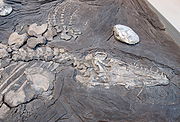 The type specimen of Platecarpus (P. planiforms) was discovered by Professor B. F. Mudge and was classified by Edward Drinker Cope
The type specimen of Platecarpus (P. planiforms) was discovered by Professor B. F. Mudge and was classified by Edward Drinker Cope
as Clidastes
planiformes. In 1898, on further analysis of the remains, it was determined that the mosasaur be placed in a separate genus, Platecarpus. The type specimen underwent another taxonomic review in 1967, when paleontologist
Dale Russell
determined that the remains were too fragmentary to be placed within any genus, and deemed it to be a specimen of "uncertain taxonomic position". A 2006 discovery in the Smoky Hill Chalk
of Kansas re-affirmed this position with the discovery a complete fossilized skull being unearthed.
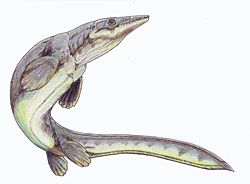 While mosasaurs are traditionally thought to have propelled themselves through the water by lateral ungulation in a similar way to eels, the deep caudal fin of Platecarpus suggests that it swam more like a shark. The downturned caudal vertebrae of Platecarpus suggest it had a crescent-shaped tail fluke. At the point of the tail where the fluke begins the vertebral centra are shortened and disk-like. Their reduced size likely allowed for greater flexibility at an area that would have experienced high stresses during swimming. The neural spines of these vertebrae also have grooves for the insertion of interspinal ligament
While mosasaurs are traditionally thought to have propelled themselves through the water by lateral ungulation in a similar way to eels, the deep caudal fin of Platecarpus suggests that it swam more like a shark. The downturned caudal vertebrae of Platecarpus suggest it had a crescent-shaped tail fluke. At the point of the tail where the fluke begins the vertebral centra are shortened and disk-like. Their reduced size likely allowed for greater flexibility at an area that would have experienced high stresses during swimming. The neural spines of these vertebrae also have grooves for the insertion of interspinal ligament
s and dorsal connective tissues which would have aided in lateral movement of the fluke. The ligaments were probably made of collagenous fibers that acted as springs to move the tail back into a resting position after energy was stored in them. These types of ligaments work in some living fish to conserve energy during repetitive bending of the tail. While the fluke and back of the tail undulated in Platecarpus, the base of the tail remained stable. This form of movement is known as carangiform locomotion.
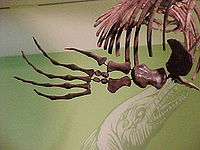 The structure of the scales of Platecarpus may have been another adaptation toward a marine lifestyle. The small size and similar shape of these scales throughout the body would have stiffened the trunk, making it more resistant to lateral movement. This stiffness would have improved hydrodynamic efficiency by improving the flow of water across the body. The early mosasauroid Vallecillosaurus
The structure of the scales of Platecarpus may have been another adaptation toward a marine lifestyle. The small size and similar shape of these scales throughout the body would have stiffened the trunk, making it more resistant to lateral movement. This stiffness would have improved hydrodynamic efficiency by improving the flow of water across the body. The early mosasauroid Vallecillosaurus
also preserves body scales, but they are larger and more varied in shape, suggesting that the animal relied on undulatory movement in its trunk rather than just its tail. Plotosaurus
, a more derived mosasaur than Platecarpus, has even smaller scales covering its body, indicating that it had even more efficient locomotion in the water.
Genus
In biology, a genus is a low-level taxonomic rank used in the biological classification of living and fossil organisms, which is an example of definition by genus and differentia...
of aquatic lizard
Lizard
Lizards are a widespread group of squamate reptiles, with nearly 3800 species, ranging across all continents except Antarctica as well as most oceanic island chains...
belonging to the mosasaur
Mosasaur
Mosasaurs are large extinct marine lizards. The first fossil remains were discovered in a limestone quarry at Maastricht on the Meuse in 1764...
family, living around 75 million years ago during the end of the Cretaceous
Cretaceous
The Cretaceous , derived from the Latin "creta" , usually abbreviated K for its German translation Kreide , is a geologic period and system from circa to million years ago. In the geologic timescale, the Cretaceous follows the Jurassic period and is followed by the Paleogene period of the...
period. Fossil
Fossil
Fossils are the preserved remains or traces of animals , plants, and other organisms from the remote past...
s have been found in Belgium
Belgium
Belgium , officially the Kingdom of Belgium, is a federal state in Western Europe. It is a founding member of the European Union and hosts the EU's headquarters, and those of several other major international organisations such as NATO.Belgium is also a member of, or affiliated to, many...
and the United States
United States
The United States of America is a federal constitutional republic comprising fifty states and a federal district...
as well as a possible specimen in Africa
Africa
Africa is the world's second largest and second most populous continent, after Asia. At about 30.2 million km² including adjacent islands, it covers 6% of the Earth's total surface area and 20.4% of the total land area...
. Platecarpus probably fed on fish
Fish
Fish are a paraphyletic group of organisms that consist of all gill-bearing aquatic vertebrate animals that lack limbs with digits. Included in this definition are the living hagfish, lampreys, and cartilaginous and bony fish, as well as various extinct related groups...
, squid
Squid
Squid are cephalopods of the order Teuthida, which comprises around 300 species. Like all other cephalopods, squid have a distinct head, bilateral symmetry, a mantle, and arms. Squid, like cuttlefish, have eight arms arranged in pairs and two, usually longer, tentacles...
, and ammonite
Ammonite
Ammonite, as a zoological or paleontological term, refers to any member of the Ammonoidea an extinct subclass within the Molluscan class Cephalopoda which are more closely related to living coleoids Ammonite, as a zoological or paleontological term, refers to any member of the Ammonoidea an extinct...
s. Like other mosasaurs, it was initially thought to have swum in an eel
Eel
Eels are an order of fish, which consists of four suborders, 20 families, 111 genera and approximately 800 species. Most eels are predators...
-like fashion, although a recent study suggests that it swam more like modern sharks. An exceptionally well-preserved specimen of P. tympaniticus known as LACM 128319 shows skin impressions, pigments around the nostrils, bronchial tubes and the presence of a high profile tail fluke, showing that it and other mosasaurs did not necessarily have an eel-like swimming method but were more powerful fast swimmers. It is held in the Natural History Museum of Los Angeles County
Natural History Museum of Los Angeles County
The Natural History Museum of Los Angeles County opened in Exposition Park, Los Angeles, California, USA in 1913 as the Museum of History, Science, and Art. The moving force behind it was a museum association founded in 1910. Its distinctive main building, with fitted marble walls and domed and...
.
Description
Platecarpus had a long, down-turned tail with a large dorsal lobe on it, steering flippers, and jaws lined with conical teeth. It grew up to 4.3 metres (14.1 ft) long, with half of that length taken up by its tail. The platecarpine mosasaurs had evolved into the very specialized plioplatecarpine group by the end of the CretaceousCretaceous
The Cretaceous , derived from the Latin "creta" , usually abbreviated K for its German translation Kreide , is a geologic period and system from circa to million years ago. In the geologic timescale, the Cretaceous follows the Jurassic period and is followed by the Paleogene period of the...
.

Plioplatecarpus
Plioplatecarpus is a genus of mosasaur lizard. Like all mosasaurs, it lived in the late Cretaceous period, about 83.5 million years ago.-Description:...
from the Lower Demopolis Formation in Alabama that has a lower number of teeth in its jaws. LACM 128319 preserves matter within the sclerotic ring
Sclerotic ring
Sclerotic rings are rings of bone found in the eyes of several groups of vertebrate animals, except for mammals and crocodilians. They can be made up of single bones or small bones together. They are believed to have a role in supporting the eye, especially in animals whose eyes are not spherical,...
that may possibly be the retina
Retina
The vertebrate retina is a light-sensitive tissue lining the inner surface of the eye. The optics of the eye create an image of the visual world on the retina, which serves much the same function as the film in a camera. Light striking the retina initiates a cascade of chemical and electrical...
of the eye. Small structures in the retina, each around 2 µm long and observed by scanning electron microspectroscopy
Scanning electron microscope
A scanning electron microscope is a type of electron microscope that images a sample by scanning it with a high-energy beam of electrons in a raster scan pattern...
, may represent retinal melanosome
Melanosome
In a biological cell, a melanosome is an organelle containing melanin, the most common light-absorbing pigment found in the animal kingdom.Cells that synthesize melanins are called melanocytes, and also the retinal pigment epithelium cells, whereas cells that have merely engulfed the melanosomes...
s preserved in their original positions.
The respiratory tube
Vertebrate trachea
In tetrapod anatomy the trachea, or windpipe, is a tube that connects the pharynx or larynx to the lungs, allowing the passage of air. It is lined with pseudostratified ciliated columnar epithelium cells with goblet cells that produce mucus...
is also known in LACM 128319, preserved as cartilaginous tracheal rings. Only the posterior-most end of the tracheal tube - at the end of the neck near the pectoral girdle - is known. The section where the two bronchi split was also preserved in the specimen, but was destroyed during excavation. This is an indication that Platecarpus and other mosasaurs had two functional lungs. Snakes, which are closely related to mosasaurs, have only one functional lung with the second often being vestigial or absent. Unlike terrestrial lizards, however, the bronchi separate in front of the area of the forelimbs rather than at the level of the limbs.
Skin impressions are known from Platecarpus, preserved in LACM 128319 as soft impressions and phosphate
Phosphate
A phosphate, an inorganic chemical, is a salt of phosphoric acid. In organic chemistry, a phosphate, or organophosphate, is an ester of phosphoric acid. Organic phosphates are important in biochemistry and biogeochemistry or ecology. Inorganic phosphates are mined to obtain phosphorus for use in...
material. Scales on the tip of the snout and the top of the skull are somewhat hexagonal in shape and do not touch one another. The scales on the jaws are longer and rhomboidal in shape, overlapping one another. The scales on the snout indicate that the nostrils were placed far in front of the skull at its tip and faced laterally as in most squamates and archosaur
Archosaur
Archosaurs are a group of diapsid amniotes whose living representatives consist of modern birds and crocodilians. This group also includes all extinct non-avian dinosaurs, many extinct crocodilian relatives, and pterosaurs. Archosauria, the archosaur clade, is a crown group that includes the most...
s. The body scales are all rhomboidal in shape and form tightly connecting diagonal rows that overlap each other at their posterior edges. They are generally the same size throughout the entire length of the body. The caudal scales on the tail are taller and larger than those of the rest of the body, although those covering the lower surface of the tail are more similar to body scales.
Internal organs, or viscera, may also be preserved in the specimen as reddish areas. One is located in the thoracic cavity
Thoracic cavity
The thoracic cavity is the chamber of the human body that is protected by the thoracic wall ....
low in the ribcage, while the other is located in the upper portion of the abdominal cavity
Abdominal cavity
The abdominal cavity is the body cavity of the human body that holds the bulk of the viscera. It is located below the thoracic cavity, and above the pelvic cavity. Its dome-shaped roof is the thoracic diaphragm , and its oblique floor is the pelvic inlet...
just behind the ribcage. The reddish areas were analysed with mass spectrometry
Mass spectrometry
Mass spectrometry is an analytical technique that measures the mass-to-charge ratio of charged particles.It is used for determining masses of particles, for determining the elemental composition of a sample or molecule, and for elucidating the chemical structures of molecules, such as peptides and...
and were shown to contain high levels of compounds made of iron
Iron
Iron is a chemical element with the symbol Fe and atomic number 26. It is a metal in the first transition series. It is the most common element forming the planet Earth as a whole, forming much of Earth's outer and inner core. It is the fourth most common element in the Earth's crust...
and porphyrin
Porphyrin
Porphyrins are a group of organic compounds, many naturally occurring. One of the best-known porphyrins is heme, the pigment in red blood cells; heme is a cofactor of the protein hemoglobin. Porphyrins are heterocyclic macrocycles composed of four modified pyrrole subunits interconnected at...
. These substances are evidence of hemoglobin
Hemoglobin
Hemoglobin is the iron-containing oxygen-transport metalloprotein in the red blood cells of all vertebrates, with the exception of the fish family Channichthyidae, as well as the tissues of some invertebrates...
decomposition products that may have formed in the organs as they decomposed. Based on its position, the organ in the thoracic cavity is probably the heart or liver, or even both of those organs. The organ in the abdominal cavity may be a kidney
Kidney
The kidneys, organs with several functions, serve essential regulatory roles in most animals, including vertebrates and some invertebrates. They are essential in the urinary system and also serve homeostatic functions such as the regulation of electrolytes, maintenance of acid–base balance, and...
, although it is in a more anterior position than the kidneys of monitor lizard
Monitor lizard
Monitor lizards are usually large reptiles, although some can be as small as in length. They have long necks, powerful tails and claws, and well-developed limbs. Most species are terrestrial, but arboreal and semiaquatic monitors are also known...
s, mosasaurs' closest living relatives. The anterior position of the kidneys may have been an adaptation toward a more streamlined body, as their presumed position is similar to that of cetaceans.
Part of the digestive tract is also preserved and is filled with fish remains. The shape of these remains may outline the true shape of the corresponding part of the digestive tract, most likely the colon
Colon (anatomy)
The colon is the last part of the digestive system in most vertebrates; it extracts water and salt from solid wastes before they are eliminated from the body, and is the site in which flora-aided fermentation of unabsorbed material occurs. Unlike the small intestine, the colon does not play a...
. The presence of scales and undigested bones in the colon suggests that Platecarpus and other mosasaurs processed food quickly and did not thoroughly digest and absorb all food in the gastrointestinal tract. Coprolites from the mosasaur Globidens
Globidens
Globidens is an extinct genus of mosasaur lizard.Globidens alabamaensis was first described by Gilmore . A second species was described by Russell . The third North American species Globidens ("Globe teeth") is an extinct genus of mosasaur lizard.Globidens alabamaensis was first described by...
are also suggestive of low digestion and absorption rates as they contain masses of crushed bivalve shells.
The caudal, or tail vertebrae, are sharply downturned. The vertebrae at the bend (called the caudal peduncle) are wedge shaped with neural spines that are wider at their ends than they are at their bases. This downturned area likely supported a fluke similar to modern sharks. Two lobes would have been present: a lower one supported by the downturned vertebrae and an upper, unsupported one. The tail fluke was probably hypocercal, meaning that its lower lobe was longer than its upper lobe. This condition is also seen in ichthyosaur
Ichthyosaur
Ichthyosaurs were giant marine reptiles that resembled fish and dolphins...
s and metriorhynchid crocodyliforms.
Fossils

Fossil
Fossils are the preserved remains or traces of animals , plants, and other organisms from the remote past...
s have been found in rocks that date back to the late Coniacian
Coniacian
The Coniacian is an age or stage in the geologic timescale. It is a subdivision of the Late Cretaceous epoch or Upper Cretaceous series and spans the time between 89.3 ± 1 Ma and 85.8 ± 0.7 Ma...
through the early Campanian
Campanian
The Campanian is, in the ICS' geologic timescale, the fifth of six ages of the Late Cretaceous epoch . The Campanian spans the time from 83.5 ± 0.7 Ma to 70.6 ± 0.6 Ma ...
in the Smoky Hill Chalk.
Taxonomic History
Platecarpus was probably the most common genus of mosasaur in the Western Interior Sea during the deposition of the Smoky Hill ChalkSmoky Hill Chalk
The Smoky Hill Chalk Member of the Niobrara Chalk formation is a Cretaceous conservation Lagerstätte, or fossil rich geological formation, known primarily for its exceptionally well-preserved marine reptiles. The Smoky Hill Chalk Member is the uppermost of the two structural units of the Niobrara...
in Kansas, and Platecarpus ictericus is the most commonly occurring species. There is some controversy regarding the description of the genus Platecarpus since it includes some diverse, and possibly unrelated forms.

Edward Drinker Cope
Edward Drinker Cope was an American paleontologist and comparative anatomist, as well as a noted herpetologist and ichthyologist. Born to a wealthy Quaker family, Cope distinguished himself as a child prodigy interested in science; he published his first scientific paper at the age of nineteen...
as Clidastes
Clidastes
Clidastes is an extinct genus of mosasaur lizard from marine environments of the Late Cretaceous.Clidastes was an agile and fast swimmer that cruised the surface or shallow waters hunting for fish, flying reptiles and anything that got too close.- Appearance :Clidastes was the smallest of the...
planiformes. In 1898, on further analysis of the remains, it was determined that the mosasaur be placed in a separate genus, Platecarpus. The type specimen underwent another taxonomic review in 1967, when paleontologist
Paleontology
Paleontology "old, ancient", ὄν, ὀντ- "being, creature", and λόγος "speech, thought") is the study of prehistoric life. It includes the study of fossils to determine organisms' evolution and interactions with each other and their environments...
Dale Russell
Dale Russell
Dale A. Russell is a Canadian geologist/palaeontologist, currently Research Professor at The Department of Marine Earth and Atmospheric Sciences of North Carolina State University...
determined that the remains were too fragmentary to be placed within any genus, and deemed it to be a specimen of "uncertain taxonomic position". A 2006 discovery in the Smoky Hill Chalk
Smoky Hill Chalk
The Smoky Hill Chalk Member of the Niobrara Chalk formation is a Cretaceous conservation Lagerstätte, or fossil rich geological formation, known primarily for its exceptionally well-preserved marine reptiles. The Smoky Hill Chalk Member is the uppermost of the two structural units of the Niobrara...
of Kansas re-affirmed this position with the discovery a complete fossilized skull being unearthed.
Diet
Compared to the tylosaurs, plioplatecarpine mosasaurs had much less robust teeth, suggesting that they fed on smaller (or softer) prey such as small fish and squid.Locomotion

Interspinal ligament
The interspinal ligaments , thin and membranous, connect adjoining spinous processes and extend from the root to the apex of each process.They meet the ligamenta flava in front and the supraspinal ligament behind....
s and dorsal connective tissues which would have aided in lateral movement of the fluke. The ligaments were probably made of collagenous fibers that acted as springs to move the tail back into a resting position after energy was stored in them. These types of ligaments work in some living fish to conserve energy during repetitive bending of the tail. While the fluke and back of the tail undulated in Platecarpus, the base of the tail remained stable. This form of movement is known as carangiform locomotion.

Vallecillosaurus
Vallecillosaurus was a genus of mosasauroid from the Late Cretaceous period....
also preserves body scales, but they are larger and more varied in shape, suggesting that the animal relied on undulatory movement in its trunk rather than just its tail. Plotosaurus
Plotosaurus
Plotosaurus is an extinct genus of mosasaur from the Upper Cretaceous of Fresno County, California. Originally named Kolposaurus by Berkeley paleontologist Charles Lewis Camp in 1942, it was changed to Plotosaurus in 1951 when Camp discovered the name had already been assigned to a type of...
, a more derived mosasaur than Platecarpus, has even smaller scales covering its body, indicating that it had even more efficient locomotion in the water.

